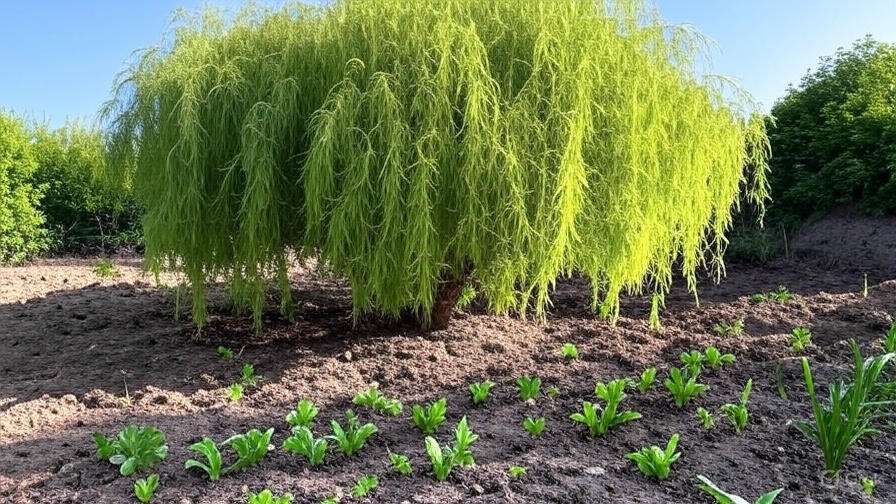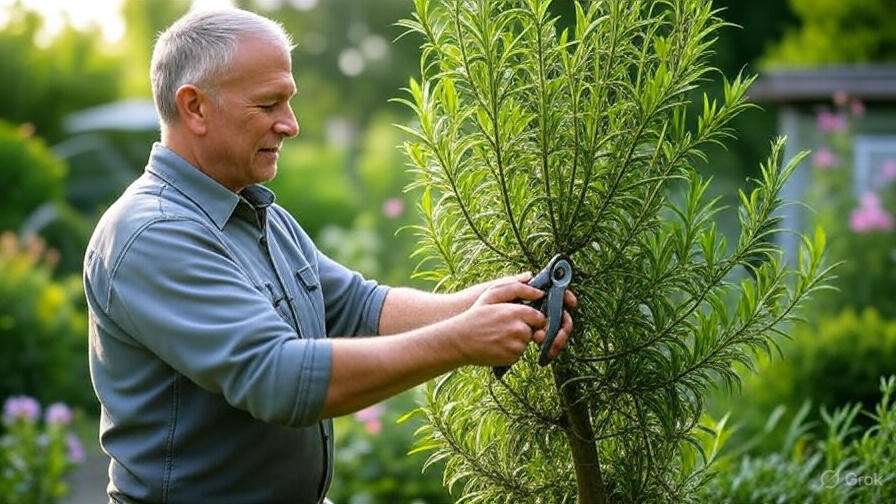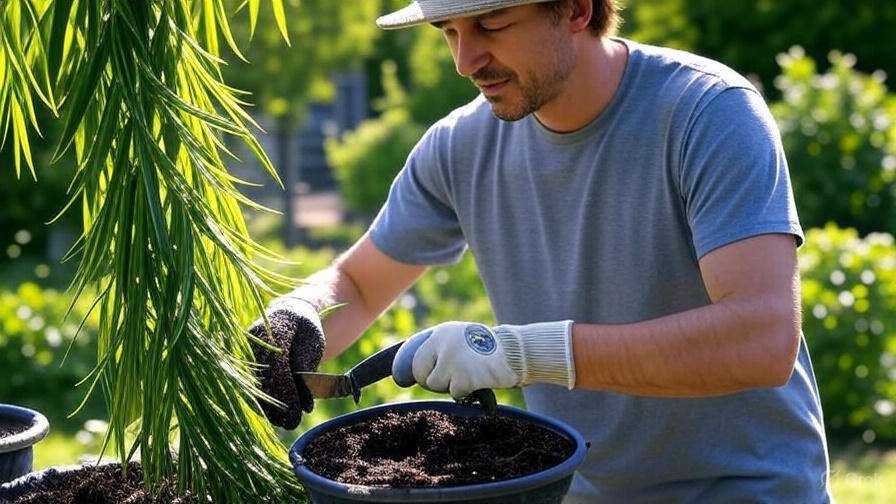
How to Care for Curly Willow Branches: Essential Tips for Healthy Growth
Curly willow branches are a beautiful addition to any landscape, with their unique spiraling shape and vibrant green color. 
If you’re unsure how to keep your curly willow branches in top condition, you’re not alone! Many gardeners struggle with providing the right care for these distinctive branches. In this guide, we’ll walk you through the essential tips for keeping your curly willow branches healthy and thriving, so they add beauty and charm to your space year after year. Keep reading to learn everything you need to know!
Table of Contents
ToggleUnderstanding Curly Willow Branches 
Curly willow branches are a unique and eye-catching feature in any garden or landscape. These branches, characterized by their twisted and curly form, belong to the Salix family, often used for decorative purposes in both fresh and dried arrangements. Understanding these branches’ basic characteristics is key to keeping them healthy and vibrant.

What Are Curly Willow Branches?
Curly willow branches come from the curly willow tree, scientifically known as Salix matsudana. The most notable feature of these branches is their corkscrew-like twist, which gives them a distinct look. These trees thrive in wet conditions and are often found near streams or wetlands. They are fast-growing and can reach up to 20 feet in height.
Why Are Curly Willow Branches Popular?
Their unique appearance and ease of growth make curly willow branches popular in floral arrangements, as well as a stunning natural feature in gardens. They are often used for crafting, centerpieces, and even as a living sculpture in landscapes.
Benefits of Curly Willow
Aside from their aesthetic appeal, curly willow branches are also incredibly easy to maintain. They can be pruned to the desired length, and their growth habits make them ideal for creating visually striking displays. Plus, they tend to adapt well to different climates, making them a versatile addition to your garden.
By understanding the basics of curly willow branches, you’ll be better equipped to care for them, ensuring they stay healthy and continue to add beauty to your outdoor space for years to come.
Best Growing Conditions for Curly Willow Branches 
Curly Willow branches thrive in specific conditions that mimic their natural habitat. Providing the right environment for them is essential to ensure they grow strong and healthy. Here’s a breakdown of the best conditions to promote optimal growth:
1. Sunlight 
Curly Willow loves the sun! They grow best in full sun, which means at least 6 hours of direct sunlight daily. The more sunlight they get, the stronger and more vibrant their curly branches will be. If you’re planting them in your garden, choose a spot that gets plenty of sunlight throughout the day.

2. Soil Type 
Well-draining, moist soil is key. Curly Willows are not picky, but they do need soil that doesn’t hold onto water for too long. Loamy soil with a mix of sand and organic matter is ideal. If your soil is heavy or clay-like, you can improve drainage by mixing in compost or sand. This ensures that the roots don’t drown in standing water, which can lead to root rot.
3. Watering Needs 
These trees love moisture, so it’s important to keep the soil consistently moist, especially during the growing season. However, be cautious not to overwater! Standing water can be detrimental. Regular deep watering once a week should suffice, but during very hot weather, you may need to water more often. Be sure the soil feels slightly damp, not soggy.
4. Temperature 
Curly Willows are adaptable to a range of temperatures but do best in moderate climates. They can tolerate cold winters and heat, but temperatures between 60°F (15°C) and 75°F (24°C) are perfect for their growth. If you live in an area with extreme temperatures, consider planting them in a sheltered location to protect them from harsh conditions.
5. Space to Grow 
These trees can grow quite large, so give them enough space to spread. Curly Willow branches can reach up to 30 feet in height and width, depending on the variety. Be sure to plant them away from structures, fences, or other plants that might restrict their growth. This will help them maintain their beautiful shape and flow freely.
By ensuring these conditions, your Curly Willow branches will thrive, giving you a stunning, twisting tree that’s sure to be the highlight of your garden!
Pruning and Shaping Curly Willow Branches 
Pruning curly willow branches is key to maintaining the plant’s health, appearance, and overall growth. Regular pruning helps prevent overcrowding, encourages stronger growth, and enhances the plant’s natural shape. Here’s a simple guide to get you started:
1. When to Prune 
Pruning curly willow is best done during late winter or early spring, just before new growth begins. This is when the tree is still dormant, reducing the risk of damaging new shoots. Pruning at this time also stimulates healthy, vigorous growth once the warmer months arrive.

2. Tools You’ll Need 
Use sharp, clean pruning shears or a pruning saw for larger branches. Make sure your tools are sanitized to prevent the spread of disease. Clean cuts heal faster, ensuring the tree stays healthy.
3. What to Cut 
Start by removing dead, damaged, or diseased branches. These can hinder healthy growth and make the tree more susceptible to pests and diseases. Then, thin out the interior branches to allow better air circulation and sunlight penetration, which is vital for overall health. You can also cut back any branches that are growing inward or crossing each other, which could eventually cause damage.
4. Shaping the Tree 
Curly willows naturally grow in a flowing, twisting shape, so it’s important to encourage this characteristic. Focus on cutting back the longest branches to maintain a balanced, attractive silhouette. If you’re aiming for a more structured look, shape the tree by cutting back the outermost branches and encouraging growth toward the center.
5. How Much to Cut 
Don’t overdo it—aim to remove no more than one-third of the tree’s growth in a single year. Over-pruning can lead to weak regrowth, so take it slow. If your tree has been neglected for a while, spread out your pruning over a couple of seasons.
6. Aftercare 
Once you’re done pruning, give the tree a good watering to help it recover. Mulching around the base will also help retain moisture and improve soil health. Keep an eye on the tree throughout the growing season to ensure that it’s thriving and free from pests.
7. Why Pruning Matters 
Regular pruning encourages stronger, healthier growth and improves the appearance of your curly willow. It can also extend the lifespan of the tree, preventing common problems like disease and pests from taking root.
With these simple pruning and shaping tips, your curly willow branches will stay healthy, vibrant, and beautifully shaped year after year.
Fertilizing Curly Willow Branches
Proper fertilization is key to ensuring your curly willow branches thrive and grow strong. Whether you’re nurturing a new plant or maintaining an established one, the right nutrients can make all the difference. Here’s a simple guide to help you fertilize your curly willow effectively.
1. Choose the Right Fertilizer 
For curly willows, a balanced, slow-release fertilizer is ideal. Look for a fertilizer with an equal ratio of nitrogen (N), phosphorus (P), and potassium (K)—usually labeled as 10-10-10. This balance supports healthy root development, encourages growth, and boosts overall plant health.

2. When to Fertilize 
Fertilizing in the spring is the best time to kickstart your willow’s growth. Apply fertilizer when new growth starts to appear. Avoid fertilizing too late in the season, as this can encourage tender new growth that might not survive through the winter.
3. How to Apply the Fertilizer 
- Granular Fertilizer: Scatter the fertilizer around the base of the plant, about 6–12 inches away from the trunk. Water well afterward to help it dissolve into the soil.
- Liquid Fertilizer: If you prefer liquid fertilizer, mix it as directed on the label and apply it directly to the soil, again watering afterward to ensure the roots absorb it properly.
4. Avoid Over-Fertilizing 
Too much fertilizer can harm your curly willow. Over-fertilizing leads to excessive growth that can weaken the plant and make it more susceptible to pests and diseases. Stick to the recommended dosage and schedule for optimal results.
5. Supplement with Organic Matter 
In addition to commercial fertilizers, consider enriching the soil with compost or organic mulch. This adds nutrients over time, improves soil structure, and helps retain moisture—perfect for curly willows that thrive in well-drained, fertile soil.
6. Monitor Growth 
After fertilizing, keep an eye on your curly willow’s growth. Healthy, vibrant green leaves and vigorous new growth are signs your tree is benefiting from the nutrients. If you notice yellowing leaves or stunted growth, it may indicate a nutrient imbalance, and you might need to adjust your fertilization plan.
By following these simple tips, your curly willow branches will grow strong, healthy, and beautifully twisted. Fertilizing at the right time and using the proper nutrients will keep your tree flourishing season after season!
Dealing with Common Problems for Curly Willow Branches
Curly willow branches are beautiful and unique, but they can face a few challenges that affect their growth. If you’re noticing issues with your curly willow, don’t worry – we’ve got some practical solutions that can help you keep your plant healthy and thriving.
1. Yellowing Leaves 
Yellowing leaves are a common sign of stress in curly willows. This could be caused by overwatering, poor drainage, or nutrient deficiencies. Here’s how to fix it:
- Check the soil moisture: Curly willows don’t like sitting in water. Ensure the soil is moist but well-draining. If it’s too soggy, consider repotting into a pot with better drainage.
- Fertilize: Yellowing might indicate a lack of nutrients. Use a balanced fertilizer to restore the necessary nutrients. Apply it during the growing season (spring and summer).
2. Pests 
Curly willows can attract pests like aphids, scale insects, and spider mites. These pests suck sap from the branches, weakening the plant and causing damage.
- Insecticidal soap: Gently spray the affected areas with insecticidal soap or neem oil. This will help manage pests without harming your plant.
- Pruning: Remove any infected branches or leaves to prevent pests from spreading.
3. Dry, Brittle Branches 
If your curly willow’s branches are becoming dry and brittle, it’s likely due to underwatering or environmental stress. Here’s what you can do:
- Water regularly: Ensure your plant is getting enough water. Curly willows love moisture but need well-draining soil to prevent root rot.
- Increase humidity: If your plant is indoors, the air can get too dry. You can increase humidity by placing a humidifier nearby or grouping your plant with other plants.
4. Stunted Growth 
If your curly willow seems to be growing slowly or not at all, it could be due to poor light or root restrictions.
- More light: Curly willows thrive in bright, indirect light. Ensure it’s not in a dark spot. If needed, move it to a location with better natural light.
- Check for root bound: If your plant is in a pot, check if the roots have outgrown the container. Repot into a larger pot to give the roots more space to grow.
By addressing these common problems, you can ensure your curly willow branches stay healthy and continue to bring beauty and character to your space. With the right care, your plant will thrive for years to come!
How to Propagate Curly Willow Branches
Propagating curly willow branches is a rewarding and simple way to grow new trees. With just a few steps, you can turn a small cutting into a thriving plant. Here’s how you can do it:
Step 1: Choose the Right Time
The best time to propagate curly willow is during the dormant season, either in late winter or early spring. This ensures the cutting has time to establish roots before the growing season begins.

Step 2: Select Healthy Cuttings 
Pick a healthy, flexible branch from your curly willow tree. The cutting should be about 6–8 inches long, with at least two nodes (the small bumps where leaves grow). Make sure the branch is free from disease or damage.
Step 3: Prepare the Cutting 
Use sharp, clean pruning shears to cut just below a node. This will encourage root development. Remove any leaves from the lower half of the cutting to reduce moisture loss and prevent rotting.
Step 4: Rooting Hormone (Optional)
While not strictly necessary, applying rooting hormone to the cut end can speed up the rooting process. Simply dip the cut end of the branch into the hormone powder and tap off the excess.
Step 5: Plant the Cutting 
Place the cutting in a container filled with well-draining potting soil. Bury the cut end of the branch about 2–3 inches deep. If you’re propagating multiple cuttings, make sure they have enough space to grow without crowding each other.
Step 6: Water and Maintain Humidity 
Water the cutting lightly, ensuring the soil is moist but not waterlogged. To increase humidity around the cutting and encourage faster rooting, cover it with a clear plastic bag or a plastic dome. Just make sure there is some airflow to prevent mold growth.
Step 7: Wait for Roots to Develop
Place the pot in a warm, sunny spot but avoid direct sunlight. Check the cutting regularly to ensure it’s still moist. Within 2–3 weeks, you should start to see roots developing. Gently tug on the cutting to feel if there’s resistance—this indicates root growth.
Step 8: Transplant to Larger Pots or Outdoors 
Once the roots are well-established, usually after about 4–6 weeks, transplant the new plant into a larger pot or directly into the ground. Be sure to choose a location with full sun and well-draining soil.
By following these simple steps, you’ll be able to propagate curly willow branches with ease. Whether you’re growing them for your garden or for decorative purposes, this method ensures you have a healthy, thriving new plant ready to flourish!
Conclusion
Caring for curly willow branches is a rewarding experience, offering both beauty and unique texture to your garden. By following the expert tips outlined in this guide, such as proper watering, pruning, and pest management, you can ensure that your curly willow tree thrives year after year. Whether you’re growing it for ornamental purposes or as part of a larger landscape, these trees are sure to add charm and elegance to any outdoor space.

Start applying these care techniques today, and watch your curly willow branches grow strong and healthy, becoming a stunning feature of your garden. 
Frequently Asked Questions(FAQ)
How often should I water my curly willow branches?
Curly willow branches need consistently moist soil, especially during dry spells. Water them deeply once a week, ensuring the soil is moist but not waterlogged. During hot weather, you may need to water more frequently.
When is the best time to prune curly willow branches?
The best time to prune curly willow branches is in late winter or early spring before new growth begins. This helps maintain the tree’s shape and removes any dead or damaged wood, promoting healthier growth.
Can I grow curly willow branches indoors?
Yes, curly willow branches can be grown indoors in a container, but they need plenty of natural sunlight to thrive. Ensure the pot is large enough for root growth and water regularly to keep the soil moist.
Why are the leaves of my curly willow branches turning yellow?
Yellowing leaves could be a sign of overwatering or a nutrient deficiency. Check the soil for proper drainage and consider applying a balanced fertilizer if needed to promote healthy growth.
How do I keep curly willow branches from breaking in the wind?
Curly willow branches can be fragile, especially in strong winds. Provide support by staking or tying the branches, especially during storms, and regularly prune them to remove excess weight and reduce the risk of breakage.
Are curly willow branches susceptible to pests?
Yes, curly willows are vulnerable to pests like aphids, willow beetles, and caterpillars. Regularly inspect your tree for pests and treat any infestations with insecticidal soap or a strong stream of water.
How can I propagate curly willow branches?
Curly willow branches are easy to propagate through cuttings. Take a 6-8 inch cutting from a healthy, young shoot, place it in water or moist soil, and wait for roots to develop before planting it in the ground.
What’s the best soil for curly willow branches?
Curly willow branches thrive in moist, well-draining soil. They prefer loamy or sandy soil but can tolerate wetter conditions. Be sure the soil is not too compacted to allow for proper root growth.





